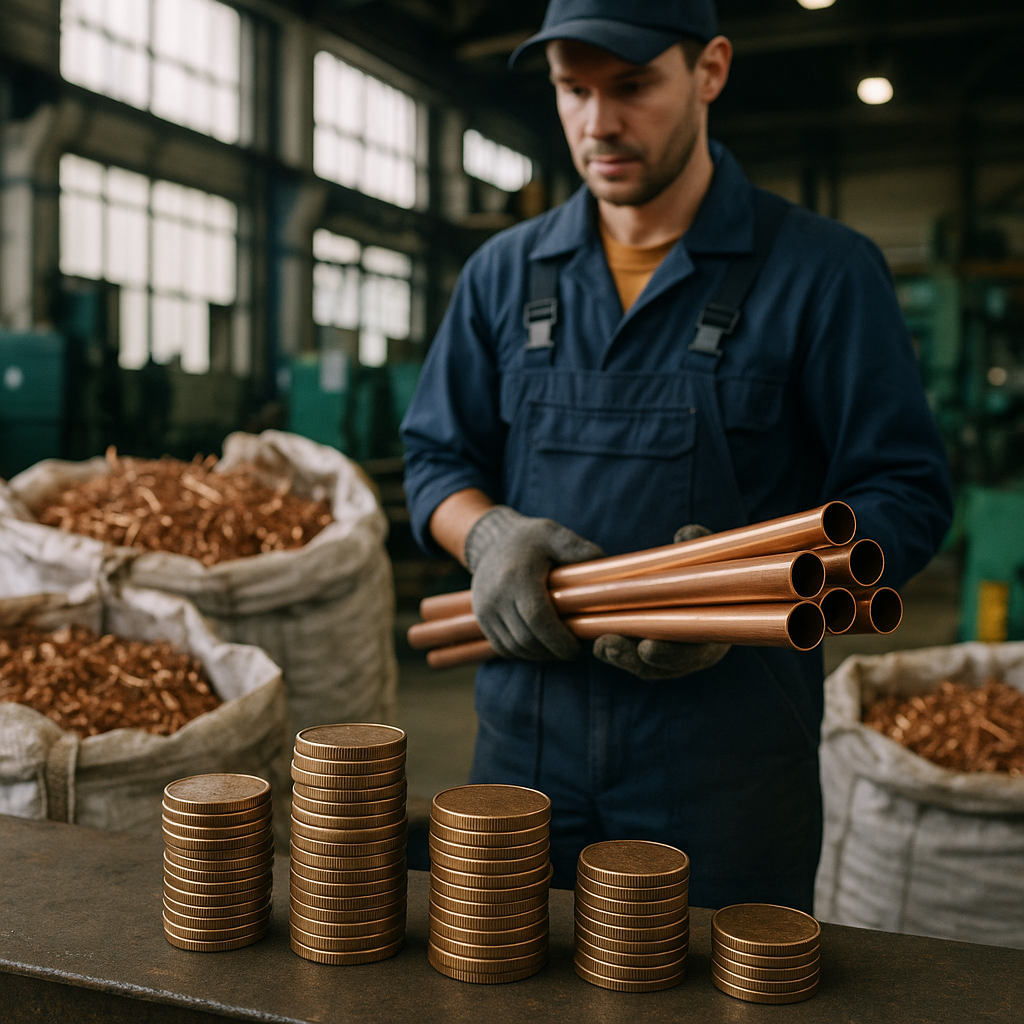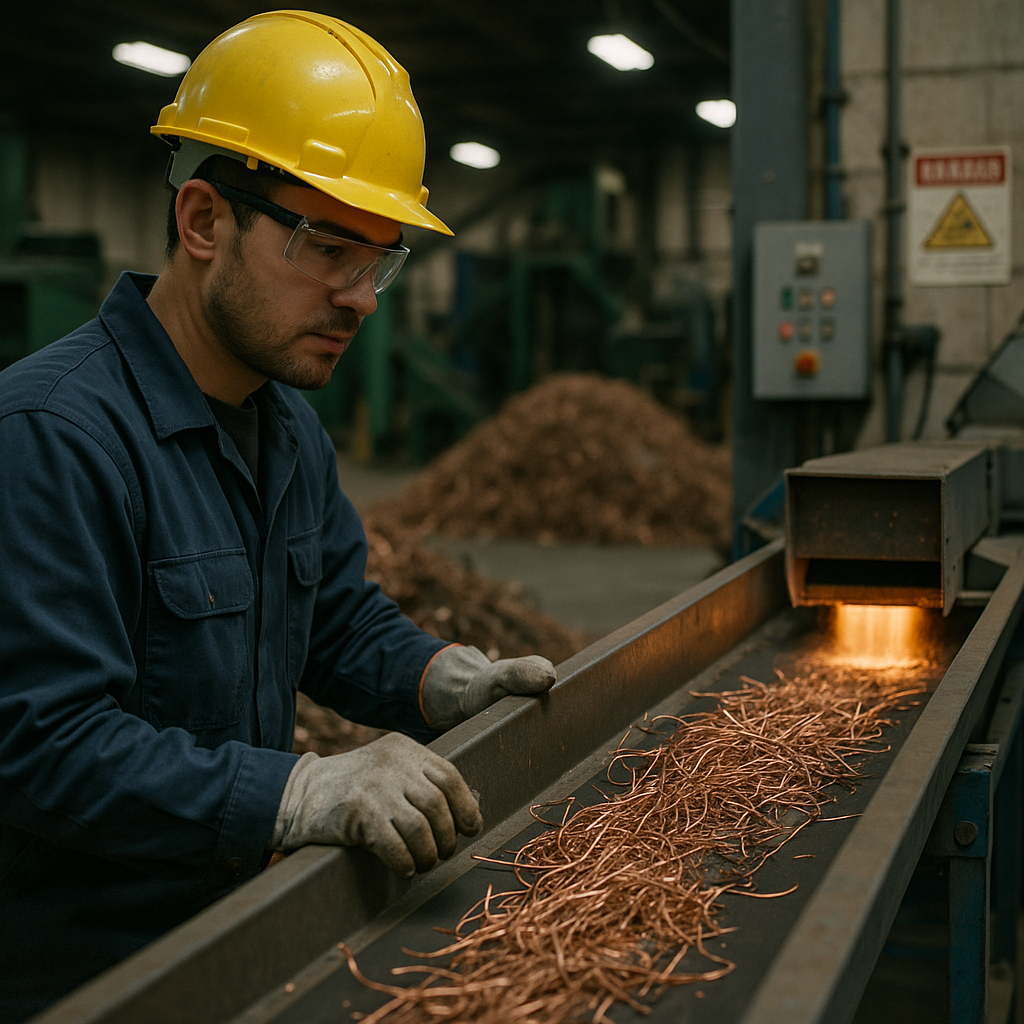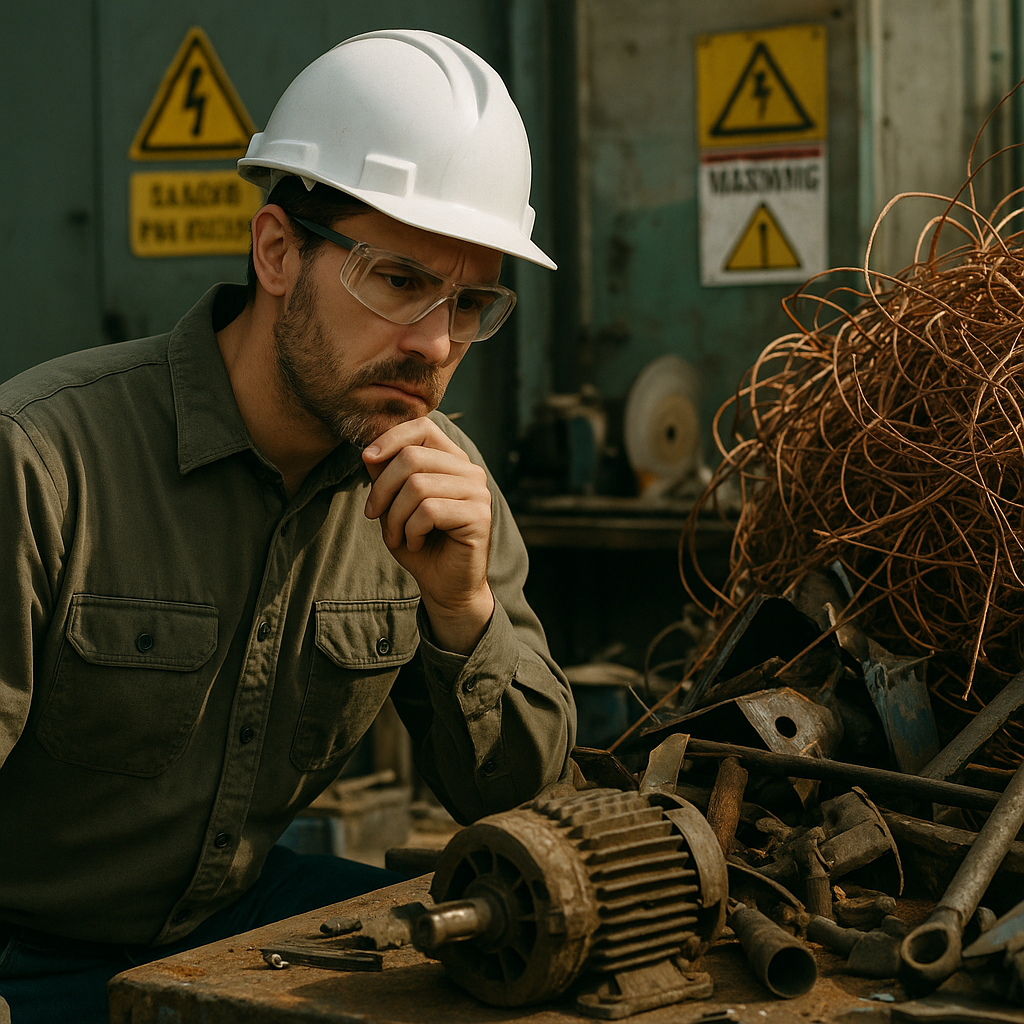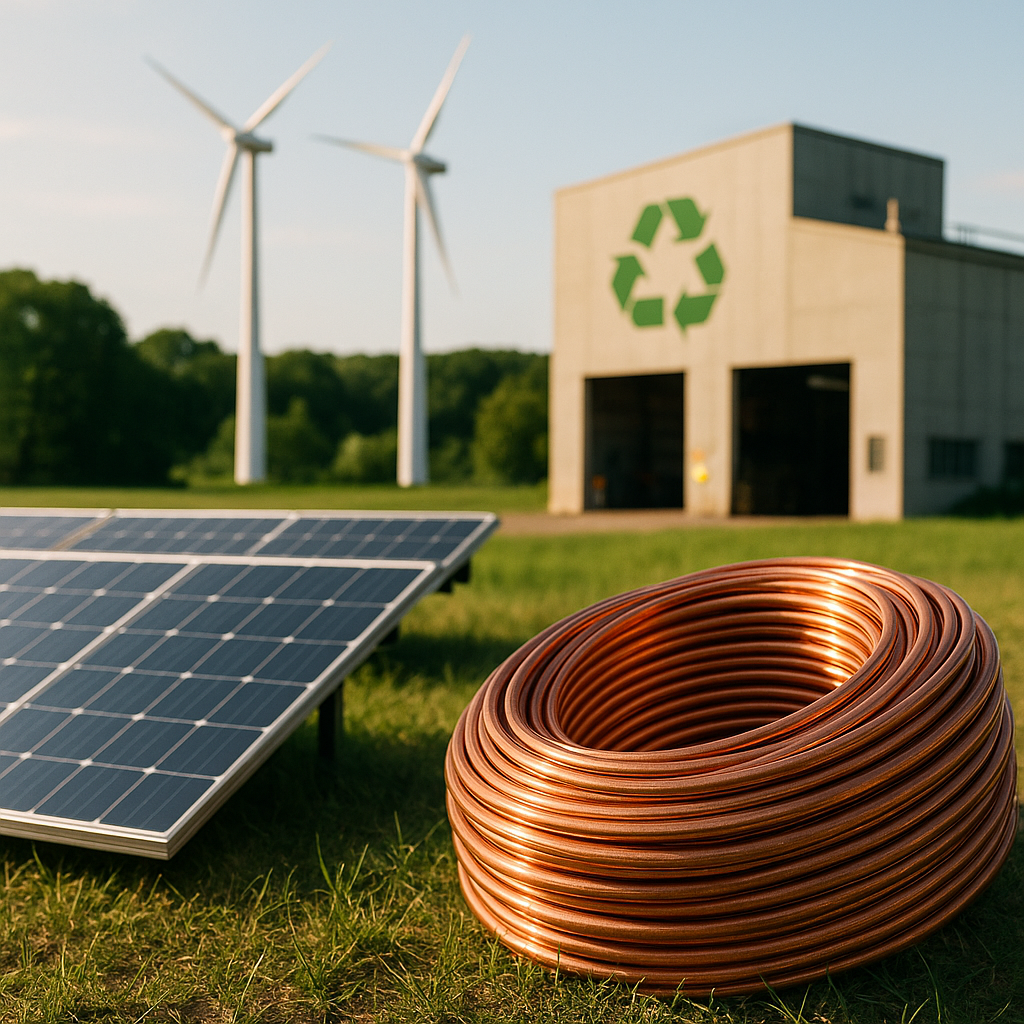5901 Botham Jean Blvd, Dallas, TX 75215
How Copper Recycling Reduces Costs, Saves Energy, and Powers Green Technologies
August 24, 2025Copper recycling transforms discarded materials into valuable resources by recovering copper from end-of-life products like electrical wires, plumbing pipes, and electronic devices. The recovered metal becomes raw material for manufacturing new products.
Copper’s perfect recyclability sets it apart. Unlike many materials that degrade during recycling, copper retains 100% of its properties, regardless of how many times it’s processed. Recycled copper matches newly mined copper in quality and performance.
The importance of copper recycling goes beyond simple material recovery. With global demand for copper rising sharply due to green energy technologies and electrification, recycling helps bridge the growing gap between copper demand and available mining supply. Current projections indicate a potential shortfall of 6.4 million tons by 2031, making every recycled pound of copper increasingly valuable for our sustainable future.
Economic Benefits of Copper Recycling

Beyond the well-known environmental advantages, the economic impact of recycling copper is equally significant. It reduces reliance on expensive mining operations, which require substantial investments in equipment, labor, and energy. By keeping valuable copper in circulation, industries can stabilize supply chains and avoid disruptions caused by fluctuating ore availability or geopolitical tensions in mining regions.
For manufacturers, recycled copper is often more cost-effective than newly mined copper, particularly when considering transportation and refining costs. The consistent quality of recycled copper—identical to virgin copper—means companies can integrate it directly into production without sacrificing performance. This cost efficiency benefits industries from electronics and construction to renewable energy development, where copper demand continues to increase.
The recycling industry also plays a crucial role in job creation and local economic growth. The collection, sorting, processing, and refining of copper scrap provide employment opportunities across the supply chain, from scrap yards and recycling facilities to advanced technology firms specializing in recovery methods. According to the Institute of Scrap Recycling Industries (ISRI), recycling generates hundreds of thousands of jobs in the U.S. alone, with copper constituting a significant part of this workforce.
Resource conservation offers another financial advantage. As copper ore grades decline worldwide, the costs of mining and refining steadily rise. Recycling offsets these increasing costs by supplying high-purity copper at a fraction of the expense, protecting industries from the volatility of raw material markets. Additionally, recycling revenues from selling scrap metal help municipalities and businesses reinvest in sustainability initiatives, creating a cycle of economic and environmental benefit.
In summary, copper recycling bolsters both global economies and local communities, ensuring that this essential material continues to support innovation and infrastructure without placing undue strain on natural resources.
How Does the Copper Recycling Process Work?

The copper recycling process transforms discarded copper materials into reusable resources through a series of specialized steps. This methodical approach ensures maximum recovery while maintaining the metal’s valuable properties. Copper is unique among recycled materials because it can be recycled repeatedly without degrading in quality.
Sorting: The Critical First Step
The recycling journey begins with thorough sorting of copper-containing materials. Scrap yards and recycling facilities separate materials based on their copper content and purity levels. High-grade copper scrap, such as bare bright wire (99% pure), is sorted separately from lower-grade materials containing other elements or insulation.
Advanced sorting techniques, including magnetic separation, help distinguish copper (which is non-magnetic) from ferrous metals. This careful categorization ensures appropriate processing methods are used for each type of material.
Shredding: Breaking Down for Efficiency
Once sorted, copper scrap undergoes shredding to reduce large pieces into manageable fragments. Industrial shredders tear through the material, creating uniform-sized pieces that expose more surface area. This critical step improves processing efficiency in subsequent stages.
For insulated copper wire, specialized wire stripping machines or granulators break down the material before separating the valuable copper from insulation through density separation techniques.
Melting: Transformation Through Heat
The shredded copper then moves to high-temperature furnaces where it’s melted at approximately 1,083°C (1,981°F). The intense heat transforms solid copper fragments into a molten state. During this phase, some impurities rise to the surface as slag and are removed.
Modern recycling facilities use energy-efficient furnaces to reduce the environmental impact of this energy-intensive step. Despite the energy required, copper recycling still consumes 85-90% less energy than extracting new copper from ore.
Purification: Refining for Quality
The molten copper undergoes purification to remove remaining contaminants and achieve desired purity levels. Electrolysis is the most common method for producing high-purity copper. In this process, copper is deposited onto cathodes while impurities remain in solution or fall to the bottom of the electrolytic cell.
Other purification methods include gas refining, where gases like oxygen are blown through molten copper to oxidize impurities, and fractional crystallization, which separates metals based on their different crystallization properties.
Solidification: Creating Usable Forms
After purification, the molten copper is cast into various forms based on intended applications. Common forms include:
- Ingots or billets for further manufacturing
- Cathodes for electrical applications
- Wire bars for wire production
- Cakes for sheet and plate production
Rapid cooling techniques are often employed to ensure proper formation of the copper structure as it solidifies.
Extrusion and Fabrication: Final Processing
Some recycled copper undergoes additional processing to create specific products. Extrusion forces copper through dies to form wires, tubes, or profiles with precise dimensions. Fabrication processes like rolling, stamping, or drawing transform copper into sheets, foils, or specialized components.
These final steps tailor the recycled copper to meet exact specifications for various industries, from electrical applications to plumbing systems.
The efficiency of this closed-loop recycling process makes copper one of the most recycled metals globally. With current technologies, recycled copper is virtually indistinguishable from newly mined copper, providing identical performance while significantly reducing environmental impact.
What Challenges Does the Copper Recycling Industry Face?

The copper recycling industry, despite its significant potential to supplement primary copper production, faces several pressing challenges that limit its effectiveness. The increasing complexity of end-of-life products containing copper presents a substantial hurdle for collection and sorting systems. Electronic waste, in particular, contains small amounts of copper dispersed throughout devices, requiring sophisticated separation technologies for efficient recovery.
Geopolitical factors introduce significant volatility into the copper recycling ecosystem. China’s implementation of its “Green Fence” policy has dramatically altered global scrap flows, creating oversupply in some markets while limiting access in others. Recent trade restrictions and resource nationalism in major copper-producing regions like Chile and Peru further complicate international recycling efforts. These tensions not only disrupt established recycling channels but also create uncertainty for long-term investment in recycling infrastructure.
The accelerating demand for copper in renewable energy technologies is rapidly outpacing current recycling capabilities. Wind turbines, solar panels, and electric vehicles require substantial copper inputs, resulting in unprecedented pressure on both primary and secondary copper sources. While primary copper mining struggles with declining ore grades and longer development timelines, the recycling industry faces its own capacity constraints in processing the growing volume of complex scrap materials.
Contamination issues represent another significant challenge. The presence of lead, iron, nickel, and other elements in copper scrap complicates recycling processes. Even small amounts of contaminants can compromise the electrical conductivity and other essential properties of recycled copper. Current refining technologies struggle to remove certain impurities cost-effectively, especially when processing lower-grade scrap sources.
Despite these challenges, the industry is responding with innovative approaches. Sensor-based sorting technologies using X-ray fluorescence (XRF) and laser-induced breakdown spectroscopy (LIBS) show promise for improving scrap identification and separation. Meanwhile, metallurgical processes are being refined to handle more diverse and contaminated inputs. The development of hybrid recycling systems that combine multiple technologies could significantly enhance recovery rates from complex waste streams.
Addressing these challenges offers opportunities to establish more resilient and sustainable copper supply chains. As global focus on circular economy principles intensifies, investments in advanced recycling technologies and infrastructure will be crucial for meeting future copper demand while reducing environmental impacts.
How Does Copper Recycling Power a Greener Future?

Copper recycling is at the forefront of our move towards a greener future. This infinitely recyclable metal retains all its properties through recycling, making it ideal for sustainable development. Recycled copper requires up to 85% less energy than mining new copper, significantly reducing carbon emissions while preserving the exceptional conductivity crucial for clean energy applications.
Recycled copper impacts multiple sectors driving environmental innovation. Wind turbines heavily rely on copper for their generators and electrical systems, with each turbine containing up to a ton. Solar power installations use copper in wiring, inverters, and transformers. Electric vehicles need two to four times more copper than conventional vehicles, using it in batteries, motors, and charging infrastructure. By meeting these needs through recycling rather than mining, the environmental footprint of green technologies is significantly reduced.
For businesses and municipalities looking to enhance their sustainability goals through responsible metal recycling, contact Okon Recycling at 214-717-4083.
